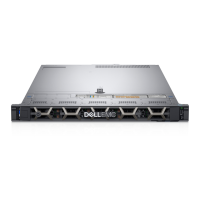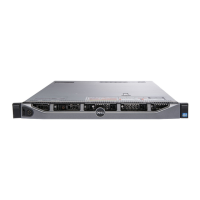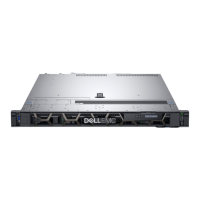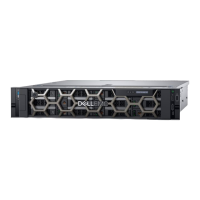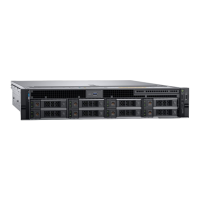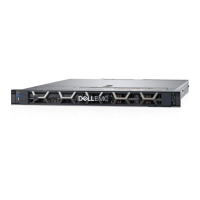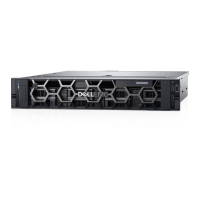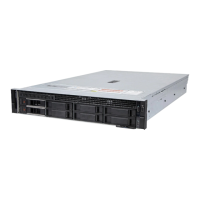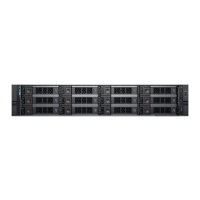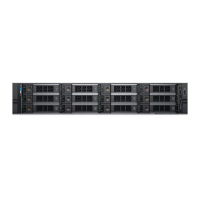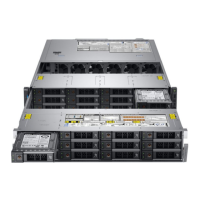Do you have a question about the Dell EMC PowerEdge R630 and is the answer not in the manual?
Lists the supported hardware configurations for the PowerEdge R630 system.
Describes the components and functions of the server's front panel.
Details the front panel components specific to the 10 x 2.5-inch hard drive chassis.
Details the front panel components specific to the 8 x 2.5-inch hard drive chassis.
Details the front panel components specific to the 24 x 1.8-inch hard drive chassis.
Explains the function and components of the front panel LCD.
Describes the components and connectors located on the rear of the server.
Covers rear panel components specific to dual-riser chassis configurations.
Covers rear panel components specific to triple-riser chassis configurations.
Explains the function and status of front panel diagnostic LEDs.
Details the LED codes for hard drive activity and status indicators.
Explains the LED codes for uSATA SSD activity and status indicators.
Describes the link and activity status indicators for the Network Interface Controller (NIC).
Explains the indicator lights for power supply status and operation.
Details the LED indicator codes for iDRAC Direct activity.
Explains the indicator lights for the Quick Sync feature.
Guides on how to locate the system's service tag for identification.
Provides detailed measurements and dimensions of the server chassis.
Specifies the weight of the server system based on its configuration.
Details the supported processor types and configurations for the system.
Lists the specifications for the supported Power Supply Units (PSUs).
Details the type and specifications of the system's battery.
Outlines the specifications for the system's expansion bus and PCIe slots.
Provides details on supported memory types, speeds, and configurations.
Lists the specifications for supported internal and external drive types.
Details the types, locations, and specifications of system ports and connectors.
Specifies the types and locations of USB ports on the system.
Details the Network Interface Controller (NIC) ports and configurations.
Describes the serial port connector and its specifications.
Specifies the VGA ports available for video output.
Details the internal dual SD module and its capabilities.
Outlines the video controller specifications and supported modes.
Provides details on operating and storage environmental conditions.
Specifies operating and storage temperature limits and conditions.
Details the acceptable ranges for relative humidity during operation and storage.
Specifies the maximum vibration levels the system can withstand.
Specifies the maximum shock levels the system can withstand.
Details the maximum operating and storage altitudes for the system.
Explains how operating temperature limits change with altitude.
Defines limitations for particulate contamination to prevent equipment damage.
Defines limitations for gaseous contamination to prevent equipment damage.
Specifies the standard operating temperature range for the system.
Lists specific operating temperature limits based on configuration.
Describes conditions for expanded operating temperature ranges.
Specifies limits for operating outside standard temperature ranges.
Step-by-step guide for initial system setup and installation.
Information and steps for configuring the Integrated Dell Remote Access Controller.
Explains methods for setting the iDRAC IP address for network communication.
Lists resources and methods for installing the operating system.
Provides instructions on how to download necessary firmware and drivers.
Overview of applications used for managing the system before the OS loads.
Access and configure BIOS, iDRAC, and other system settings.
Provides advanced embedded system management features.
Select boot options and diagnostic utilities.
Use PXE to remotely boot and configure networked systems.
Configure BIOS settings, including boot order and system passwords.
Steps to access and view the System BIOS settings.
Configure boot mode (BIOS/UEFI) and boot sequence.
Steps to access and view the Boot Settings screen.
Explains how to select between BIOS and UEFI boot modes.
Instructions on how to change the system's boot device order.
Configure PXE device settings within the system setup.
Steps to access and view the Network Settings screen.
Configure iSCSI device settings for UEFI boot mode.
Steps to access and view the UEFI iSCSI Settings.
Configure system security features like passwords and power button behavior.
Steps to access and view the System Security settings.
Detailed explanation of various system security options.
Configure custom policies for secure boot if enabled.
Steps to access and view secure boot custom policy settings.
Instructions for setting system and setup passwords.
How to protect the system using its password.
Procedures for removing or modifying system and setup passwords.
View system properties like model, BIOS version, and service tag.
Steps to access and view the system information screen.
View and configure memory settings, including tests and node interleaving.
Steps to access and view the memory settings screen.
Configure processor settings, virtualization, and power management.
Steps to access and view the processor settings screen.
Detailed explanations of various processor settings.
Configure SATA devices, including RAID setup.
Steps to access and view the SATA settings screen.
Detailed explanations of various SATA settings and drive configurations.
Continues detailed explanations of SATA settings and drive configurations.
View and configure settings for integrated devices like video and USB.
Steps to access and view the integrated devices screen.
Detailed explanations of settings for integrated devices.
Configure the watchdog timer for OS responsiveness.
Enable or disable support for PCIe devices mapped above 4 GB.
Enable or disable PCIe slots for configuration.
View properties of serial communication ports.
Steps to access and view serial communication settings.
Configure system profile settings for performance and power management.
Steps to access and view system profile settings.
Detailed explanations of various system profile settings.
Configure miscellaneous system settings like date and time.
Steps to access and view miscellaneous settings.
Detailed explanations of various miscellaneous settings.
Interface for configuring iDRAC parameters using UEFI.
Steps to access the iDRAC configuration utility.
Adjust thermal settings for cooling and fan control.
Configure parameters for various system devices.
Provides advanced embedded system management features.
Provides advanced embedded system management capabilities.
Select boot options and diagnostic utilities.
Steps to access the boot manager.
Lists the options available in the boot manager, including system setup.
Allows selection of a one-time boot device.
Accesses system utilities like diagnostics and BIOS/UEFI updates.
Use PXE to remotely boot and configure networked systems.
General safety guidelines to follow before performing any component service.
Pre-servicing procedures and precautions before accessing internal components.
Post-servicing procedures for reassembling the system.
Lists the tools required for component removal and installation.
Information about the optional front bezel and its function.
Step-by-step instructions for removing the front bezel.
Details about the system cover and its protective function.
Instructions for safely removing the system cover.
Instructions for properly installing the system cover.
Diagram showing the internal components of the server.
Information about the cooling ducts and their role in airflow.
Step-by-step instructions for removing the cooling ducts.
Step-by-step instructions for installing the cooling ducts.
Details on the system's memory modules and installation.
Information about the system's hard drive configurations and installation.
Instructions for installing or removing the optional optical drive.
Information about the system's cooling fans and their removal/installation.
Details on the optional internal USB storage device.
Information on installing and configuring expansion cards and risers.
Details about the optional SD vFlash card and its installation.
Information about the internal dual SD module.
Details on the integrated storage controller card and its installation.
Information on installing and removing the network daughter card.
Procedures for installing and removing processors and heat sinks.
Information on power supply units, including AC and DC PSUs.
Instructions for replacing the system battery.
Procedures for removing and installing the hard drive backplane.
Details about the components of the system's control panel.
Instructions for removing and installing the VGA module.
Step-by-step instructions for removing the system board.
Step-by-step instructions for installing the system board.
Continues the process of installing the system board.
Explains the function and security features of the Trusted Platform Module.
Step-by-step instructions for installing the TPM.
Guides on initializing the TPM for BitLocker encryption.
Guides on initializing the TPM for Intel TXT functionality.
Overview of the Dell Embedded Diagnostics (ePSA) program.
Steps to run diagnostics using the boot manager.
Steps to run diagnostics using the Dell Lifecycle Controller.
Explains the controls and features within the diagnostic program interface.
Details the function and settings of system board jumpers.
Information on system board jumpers, connectors, and their locations.
Procedures for disabling system and setup passwords using a jumper.
Steps to resolve issues preventing the system from booting correctly.
Steps to resolve issues with external device connections.
Steps to resolve issues related to the video subsystem.
Steps to resolve issues with USB devices.
Troubleshoots iDRAC Direct using USB XML configuration.
Troubleshoots iDRAC Direct connection with a laptop.
Steps to resolve issues with serial input and output devices.
Steps to resolve issues with the Network Interface Controller (NIC).
Steps to troubleshoot system failures caused by moisture.
Steps to troubleshoot system failures due to physical damage.
Steps to troubleshoot issues related to the system battery.
Steps to troubleshoot issues with power supply units.
Steps to troubleshoot general power-related issues.
Specific troubleshooting for power device failures.
Steps to troubleshoot issues related to the system's cooling.
Steps to troubleshoot issues with cooling fans.
Steps to troubleshoot issues with system memory modules.
Steps to troubleshoot issues with internal USB flash drives.
Steps to troubleshoot issues with micro SD cards.
Steps to troubleshoot issues with the optical drive.
Steps to troubleshoot issues with tape backup devices.
Steps to troubleshoot issues with drives or Solid State Drives (SSDs).
Steps to troubleshoot issues with storage controllers.
Steps to troubleshoot issues with expansion cards.
Steps to troubleshoot issues related to the system processor.
Information on how to contact Dell EMC for support and service.
How to provide feedback on the documentation.
Guide on using the Quick Resource Locator (QRL) for system information.
Lists the supported hardware configurations for the PowerEdge R630 system.
Describes the components and functions of the server's front panel.
Details the front panel components specific to the 10 x 2.5-inch hard drive chassis.
Details the front panel components specific to the 8 x 2.5-inch hard drive chassis.
Details the front panel components specific to the 24 x 1.8-inch hard drive chassis.
Explains the function and components of the front panel LCD.
Describes the components and connectors located on the rear of the server.
Covers rear panel components specific to dual-riser chassis configurations.
Covers rear panel components specific to triple-riser chassis configurations.
Explains the function and status of front panel diagnostic LEDs.
Details the LED codes for hard drive activity and status indicators.
Explains the LED codes for uSATA SSD activity and status indicators.
Describes the link and activity status indicators for the Network Interface Controller (NIC).
Explains the indicator lights for power supply status and operation.
Details the LED indicator codes for iDRAC Direct activity.
Explains the indicator lights for the Quick Sync feature.
Guides on how to locate the system's service tag for identification.
Provides detailed measurements and dimensions of the server chassis.
Specifies the weight of the server system based on its configuration.
Details the supported processor types and configurations for the system.
Lists the specifications for the supported Power Supply Units (PSUs).
Details the type and specifications of the system's battery.
Outlines the specifications for the system's expansion bus and PCIe slots.
Provides details on supported memory types, speeds, and configurations.
Lists the specifications for supported internal and external drive types.
Details the types, locations, and specifications of system ports and connectors.
Specifies the types and locations of USB ports on the system.
Details the Network Interface Controller (NIC) ports and configurations.
Describes the serial port connector and its specifications.
Specifies the VGA ports available for video output.
Details the internal dual SD module and its capabilities.
Outlines the video controller specifications and supported modes.
Provides details on operating and storage environmental conditions.
Specifies operating and storage temperature limits and conditions.
Details the acceptable ranges for relative humidity during operation and storage.
Specifies the maximum vibration levels the system can withstand.
Specifies the maximum shock levels the system can withstand.
Details the maximum operating and storage altitudes for the system.
Explains how operating temperature limits change with altitude.
Defines limitations for particulate contamination to prevent equipment damage.
Defines limitations for gaseous contamination to prevent equipment damage.
Specifies the standard operating temperature range for the system.
Lists specific operating temperature limits based on configuration.
Describes conditions for expanded operating temperature ranges.
Specifies limits for operating outside standard temperature ranges.
Step-by-step guide for initial system setup and installation.
Information and steps for configuring the Integrated Dell Remote Access Controller.
Explains methods for setting the iDRAC IP address for network communication.
Lists resources and methods for installing the operating system.
Provides instructions on how to download necessary firmware and drivers.
Overview of applications used for managing the system before the OS loads.
Access and configure BIOS, iDRAC, and other system settings.
Provides advanced embedded system management features.
Select boot options and diagnostic utilities.
Use PXE to remotely boot and configure networked systems.
Configure BIOS settings, including boot order and system passwords.
Steps to access and view the System BIOS settings.
Configure boot mode (BIOS/UEFI) and boot sequence.
Steps to access and view the Boot Settings screen.
Explains how to select between BIOS and UEFI boot modes.
Instructions on how to change the system's boot device order.
Configure PXE device settings within the system setup.
Steps to access and view the Network Settings screen.
Configure iSCSI device settings for UEFI boot mode.
Steps to access and view the UEFI iSCSI Settings.
Configure system security features like passwords and power button behavior.
Steps to access and view the System Security settings.
Detailed explanation of various system security options.
Configure custom policies for secure boot if enabled.
Steps to access and view secure boot custom policy settings.
Instructions for setting system and setup passwords.
How to protect the system using its password.
Procedures for removing or modifying system and setup passwords.
View system properties like model, BIOS version, and service tag.
Steps to access and view the system information screen.
View and configure memory settings, including tests and node interleaving.
Steps to access and view the memory settings screen.
Configure processor settings, virtualization, and power management.
Steps to access and view the processor settings screen.
Detailed explanations of various processor settings.
Configure SATA devices, including RAID setup.
Steps to access and view the SATA settings screen.
Detailed explanations of various SATA settings and drive configurations.
Continues detailed explanations of SATA settings and drive configurations.
View and configure settings for integrated devices like video and USB.
Steps to access and view the integrated devices screen.
Detailed explanations of settings for integrated devices.
Configure the watchdog timer for OS responsiveness.
Enable or disable support for PCIe devices mapped above 4 GB.
Enable or disable PCIe slots for configuration.
View properties of serial communication ports.
Steps to access and view serial communication settings.
Configure system profile settings for performance and power management.
Steps to access and view system profile settings.
Detailed explanations of various system profile settings.
Configure miscellaneous system settings like date and time.
Steps to access and view miscellaneous settings.
Detailed explanations of various miscellaneous settings.
Interface for configuring iDRAC parameters using UEFI.
Steps to access the iDRAC configuration utility.
Adjust thermal settings for cooling and fan control.
Configure parameters for various system devices.
Provides advanced embedded system management features.
Provides advanced embedded system management capabilities.
Select boot options and diagnostic utilities.
Steps to access the boot manager.
Lists the options available in the boot manager, including system setup.
Allows selection of a one-time boot device.
Accesses system utilities like diagnostics and BIOS/UEFI updates.
Use PXE to remotely boot and configure networked systems.
General safety guidelines to follow before performing any component service.
Pre-servicing procedures and precautions before accessing internal components.
Post-servicing procedures for reassembling the system.
Lists the tools required for component removal and installation.
Information about the optional front bezel and its function.
Step-by-step instructions for removing the front bezel.
Details about the system cover and its protective function.
Instructions for safely removing the system cover.
Instructions for properly installing the system cover.
Diagram showing the internal components of the server.
Information about the cooling ducts and their role in airflow.
Step-by-step instructions for removing the cooling ducts.
Step-by-step instructions for installing the cooling ducts.
Details on the system's memory modules and installation.
Information about the system's hard drive configurations and installation.
Instructions for installing or removing the optional optical drive.
Information about the system's cooling fans and their removal/installation.
Details on the optional internal USB storage device.
Information on installing and configuring expansion cards and risers.
Details about the optional SD vFlash card and its installation.
Information about the internal dual SD module.
Details on the integrated storage controller card and its installation.
Information on installing and removing the network daughter card.
Procedures for installing and removing processors and heat sinks.
Information on power supply units, including AC and DC PSUs.
Instructions for replacing the system battery.
Procedures for removing and installing the hard drive backplane.
Details about the components of the system's control panel.
Instructions for removing and installing the VGA module.
Step-by-step instructions for removing the system board.
Step-by-step instructions for installing the system board.
Continues the process of installing the system board.
Explains the function and security features of the Trusted Platform Module.
Step-by-step instructions for installing the TPM.
Guides on initializing the TPM for BitLocker encryption.
Guides on initializing the TPM for Intel TXT functionality.
Overview of the Dell Embedded Diagnostics (ePSA) program.
Steps to run diagnostics using the boot manager.
Steps to run diagnostics using the Dell Lifecycle Controller.
Explains the controls and features within the diagnostic program interface.
Details the function and settings of system board jumpers.
Information on system board jumpers, connectors, and their locations.
Procedures for disabling system and setup passwords using a jumper.
Steps to resolve issues preventing the system from booting correctly.
Steps to resolve issues with external device connections.
Steps to resolve issues related to the video subsystem.
Steps to resolve issues with USB devices.
Troubleshoots iDRAC Direct using USB XML configuration.
Troubleshoots iDRAC Direct connection with a laptop.
Steps to resolve issues with serial input and output devices.
Steps to resolve issues with the Network Interface Controller (NIC).
Steps to troubleshoot system failures caused by moisture.
Steps to troubleshoot system failures due to physical damage.
Steps to troubleshoot issues related to the system battery.
Steps to troubleshoot issues with power supply units.
Steps to troubleshoot general power-related issues.
Specific troubleshooting for power device failures.
Steps to troubleshoot issues related to the system's cooling.
Steps to troubleshoot issues with cooling fans.
Steps to troubleshoot issues with system memory modules.
Steps to troubleshoot issues with internal USB flash drives.
Steps to troubleshoot issues with micro SD cards.
Steps to troubleshoot issues with the optical drive.
Steps to troubleshoot issues with tape backup devices.
Steps to troubleshoot issues with drives or Solid State Drives (SSDs).
Steps to troubleshoot issues with storage controllers.
Steps to troubleshoot issues with expansion cards.
Steps to troubleshoot issues related to the system processor.
Information on how to contact Dell EMC for support and service.
How to provide feedback on the documentation.
Guide on using the Quick Resource Locator (QRL) for system information.
